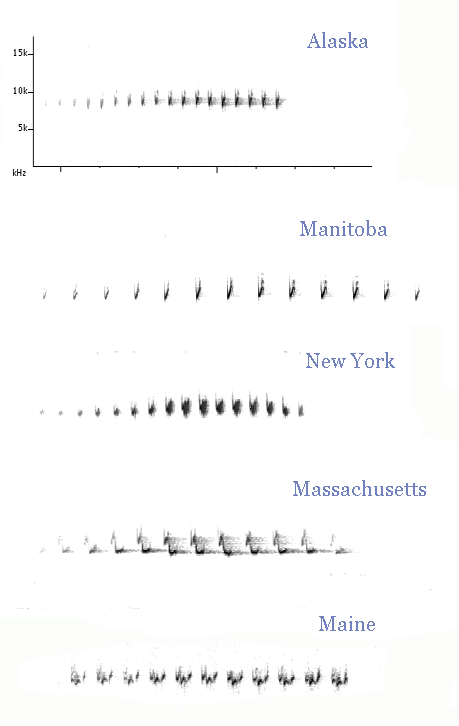I’ve been aware of some variation in songs of Blackpoll Warbler for many years, and now an interesting post by Andrew Spencer at Earbirding prompted me to check into it a little more closely. Many years ago Will Russell pointed out to me that the birds nesting in Alaska all sang a more rapid series of notes than birds in New England, and I have listened more carefully to them ever since.
I had occasionally heard fast songs among the more normal slow songs from migrants along the Atlantic coast, and from breeding birds in Maine and New Hampshire, so I never thought there was much to it – just a song variant with a slight geographic bias. The report by Spencer that these fast songs predominate in a small region of northern New Hampshire while most neighboring birds sing “normal” songs suggests the possibility of a regional dialect and makes this far more interesting.
A review of recordings in the collections of The Macauley Library of Natural Sounds reveal what seems to be significant geographic variation, and multiple recordings from each region all sound similar.

- Alaska birds sing a rapid series of very short sharp phrases: t t t t t t t t t t t
- Manitoba birds sing a much slower series, but still very short sharp phrases: t, t, t, t, t, t, t, t, t. The pauses between phrases are longer than the phrases, giving this a much more staccato sound than the eastern birds. ((In my field notes from Jasper, Alberta in 1990 I described a very fast song and an odd pulsing buzzy song from Blackpolls there, unlike the Manitoba recordings. I wonder what they sound like in northern British Columbia? Northwest Territories? Yukon?))
- Birds from the northeast typically sing a slower series than Alaskan birds, but even when the tempo is similar the overall sound is quite different because eastern birds sing longer phrases and very short pauses between phrases: tsi tsi tsi tsi tsi tsi tsi tsi. The details of the shape of each phrase are variable, but the length of each phrase means you can usually hear the slurs in each note, unlike the sharp “t” sound of the western notes, and the notes almost run together.
- Fast songs from the northeast (recordings by Andrew Spencer here) still retain the sense of a series of notes slurring together, unlike Alaska recordings such as this one in the Macauley Library.
Geographic variation in appearance is essentially nil. A western subspecies has been described (Dendroica striata lurida, said to be slightly larger and duller on average) but “the differences, if present, are too weak for subspecies recognition” (Pyle, 1997). In such a highly migratory species with an unbroken breeding range, it seems unlikely that recognizable subspecies exist, but this deserves another look. Song dialects are unusual among wood-warblers, so the existence of regional variation in song alone is very interesting. Virtually all Blackpoll warblers migrate through Florida in spring, so breeders heading for Alaska and western Canada might be heard in much of the east, and it’s likely that there are more regional song variations than the ones described here.
This needs a lot more study. I’m speculating based on a very small number of recordings, but… Wouldn’t it be cool to be able to know the breeding area of individual Blackpoll Warblers as they pass through Michigan or Minnesota, just by their song?

